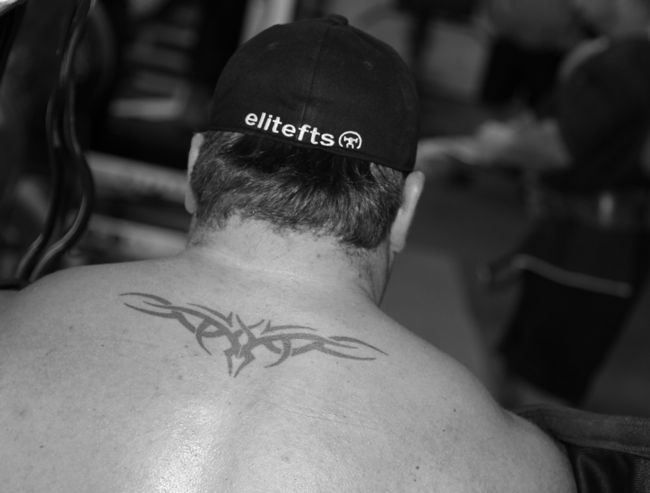
My name is Ron Dykstra. I'm not a world class athlete or famous strength coach. I'm just a lifelong trainee and strength and conditioning coach over at Bang Fitness in Toronto (bangfitnes.com). So why would I attempt to put up an article on EliteFTS? Through the dubious magic of Facebook, I “friended” Clint Darden, who is great about providing the details of his training, including pictures and videos. Paging through his pictures, you can see him lifting crazy weights with beautiful technique along with his training partners. I noticed that Clint kept his neck in a certain position compared to the other guys, so I commented on this. It snowballed, and Clint suggested I submit an article to EliteFTS.com.
This is the picture on Facebook that got the ball rolling:
This is a picture of someone who I think is one of Clint’s training partners or at least someone who visited his gym. He is using a different style but still pulling a big deadlift (I suspect that a hyperlordotic lower back could be seen from a different angle):
I've been a big fan of the EliteFTS site for the past five years. Despite the title of this article, the first time I heard of this technique was from Jim Wendler when he was describing correct squatting technique. He cleverly simplified an advanced and somewhat controversial technique. In explaining what I ultimately have heard described as “packing the neck,” Jim suggested imagining that you're wearing a backward ball cap and you're trying to push the bill backward. This is a very smart way to tap into an easily misunderstood motor pattern or engram. Charlie Weingroff, doctor of physical therapy, describes this as “strong cervical retrusion with capital flexion.” Up until this point, I had always lifted my head up, looking at a spot on the wall but tilting my chin up as I ascended, until at the end of a squat, I was essentially looking at the ceiling. At the top of a repetition, I felt powerful neck cords straining, nostrils flaring, and so on. Then I would go home and put an ice pack on my neck and back. Yes, I had constant neck irritation during that time as well as a strained lower lumbar ligament.
So I altered my neck position. Wendler led the way to Mark Rippetoe, whose strong emphasis on the neutral spine became important to me for preserving the integrity of my somewhat punished lower back. The result was a drastic reduction in neck pain. I haven’t had an icepack on my neck for a long time whereas it was a nearly daily occurrence with my previous lifting style. At that point, I didn’t think too much of it—just one more thing in the bag of tricks.
Sometime later, I became a trainer at Bang Fitness, and the topic rose again when our director of operations, Geoff Girvitz, along with one of our highly qualified trainers, Andy Dube, were discussing “packing the neck,” which the aforementioned Charlie Weingroff described wonderfully in his blog. At this time, it was decided that we hadn’t emphasized this enough and would make more of a point of it with our clients. The neutral lower back curve had been our emphasis in terms of neutral spine, but of course, the spine runs all the way up the entire back, so it can’t be said to be neutral if you're craning your head this way and that while you lift. It goes without saying that an unstable spine during a heavy lift can only lead to no good.
We’ve been working toward implementing the technique with mixed results, as some people will absolutely not relinquish the old “throw your head back” technique. While it is an easy point to argue in terms of health, it is actually impossible to argue with the fact that many lifters don't use the technique and some of them are world class lifters.
Regardless of that fact, anything that will potentially prolong a lifter’s career while improving the health of the spine and providing more quality of life (less time with an icepack on the neck and less time recovering from injury) should definitely receive your consideration as a technique tweak.
One thing that is particularly of interest in terms of how this concept was revealed to me is that I learned it from the strength community (Jim Wendler) years before I had heard of it through the science community. Science had to play catch up on this one. This closely reminds me of a similar situation. Another well-known strength professional knew for years that you should brace the abs (push them out) to truly buttress the lower back while many physiologists and chiropractors had been pushing transverse abdominus and multifidus as the big stabilizers in the abs and low back, respectively. At a seminar with Dr. Stuart McGill this past weekend, he hammered home the fact that the TA doesn't do what we thought. The multifidus is just another back muscle, and bracing the complicated architecture of the abdominals out was indeed the most effective way to buttress the lower back. As the world’s leading researcher in spinal health, he should know, but it’s very interesting to me that he had to dispel to the health care community what the strength world has known for a long time.
Thanks to Clint Darden for the kick in the pants that it took to get this written! Wishing you all PRs and healthy spines!











1 Comment